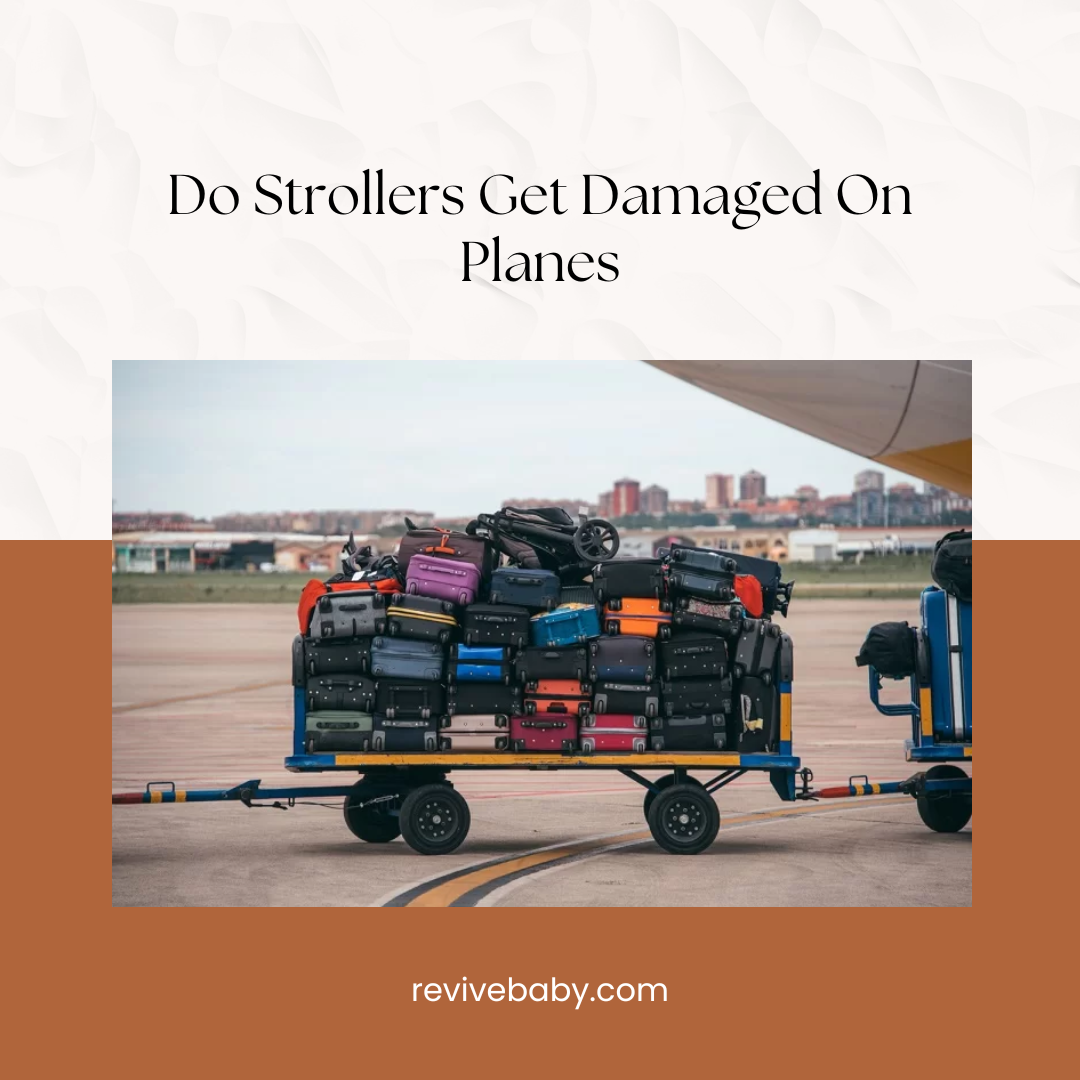However, the question that often lingers in parents' minds is whether their beloved strollers can withstand the rigors of air travel.
In this comprehensive guide, we will explore the world of stroller travel and the factors contributing to potential damage, the types of strollers most at risk, and, most importantly, how to safeguard your stroller during its time in the airplane's cargo hold or cabin.

Do Strollers Get Damaged On Planes? - Reasons And Factors
Strollers can get damaged on planes, which concerns many parents and caregivers who rely on these essential baby gear items when traveling with infants or toddlers. The potential for stroller damage during air travel arises from various factors, and here's an explanation of why it happens:
Handling by Airport and Airline Staff
Strollers are vulnerable to damage during air travel due to how airport and airline staff handle them. When passengers check in their strollers, they are often loaded and unloaded from the aircraft alongside other luggage and cargo.
Unfortunately, in some instances, strollers may be subjected to rough handling, such as tossing or mishandling, which increases the risk of structural damage.
Tight Storage Spaces
Strollers placed in the cargo hold of an aircraft face the challenge of limited storage space. They share this space with other passengers' luggage, sometimes resulting in unintentional collisions or pressure on the stroller's frame. This crowded environment can lead to dents, bent frames, or other forms of damage.
Limited Protection
Airlines usually provide plastic bags or coverings to protect strollers. However, these protective measures may not offer sufficient defense against rough handling or potential impacts from other items in the cargo hold. Strollers, especially those without proper padding or insulation, can be vulnerable to damage.
Size and Weight Restrictions
Airlines have specific size and weight restrictions for strollers that passengers must adhere to. Strollers exceeding these limits may not fit in the designated storage areas or be more prone to damage during handling and storage processes.
Varied Policies Among Airlines
Different airlines have distinct policies regarding strollers, including whether they allow gate-checking or require strollers to be checked at the ticket counter. These policy variations can lead to confusion for travelers, and not being aware of or adhering to these policies can increase the likelihood of damage.
Wear and Tear Over Time
The overall condition of a stroller can impact its susceptibility to damage during air travel. Strollers that have been extensively used or are older may have weakened spots in their frames or worn-out parts that are more likely to break or suffer damage during the journey.
Unpredictable Factors
Unforeseeable factors like turbulence during the flight or adverse weather conditions can also contribute to potential damage. Strollers not properly secured or protected may be affected by these unpredictable elements.
Are Airlines Responsible For Stroller Damage?

Airlines can be held responsible for stroller damage, but whether they are liable and to what extent depends on various factors, including airline policies, the circumstances of the damage, and applicable laws and regulations.
Airline Policies and Stroller Handling
Airlines have specific policies in place for handling strollers during air travel. These policies dictate that passengers must check in their strollers at the gate or ticket counter, making the airline responsible for their proper care and transportation. However, the degree of care can vary between airlines, and passengers need to be aware of the specific procedures and guidelines of the airline they are flying with.
Documentation and Reporting
To protect their interests, passengers should thoroughly document any pre-existing damage to their stroller before checking it in for the flight. This documentation can take the form of photographs or videos, which can serve as crucial evidence if damage occurs during the journey. Equally important is promptly reporting any damage to airline personnel upon arrival. Reporting damage before leaving the airport is preferred, as it ensures the issue is documented and increases the chances of a successful damage claim.
Liability and Negligence
Airlines can be held liable for stroller damage, especially when negligence or improper handling by their staff is evident. Examples of negligence include rough handling, tossing, or dropping the stroller, which can lead to structural or cosmetic damage. Passengers should keep in mind that the burden of proof may rest on them to demonstrate that the airline's staff was at fault.
Limits of Liability
Passengers must understand that airlines, including strollers, often have predefined liability limits for damaged baggage. These limits can vary widely between airlines and may not fully cover the cost of repairing or replacing expensive strollers. Passengers should review the terms and conditions of their chosen airline to determine the specific limits in place.
Travel Insurance Coverage
Travel insurance can provide additional protection for stroller damage during air travel. Passengers should check whether their travel insurance policy includes coverage for damaged or lost baggage, including strollers. If such coverage is included, it may provide reimbursement for repairing or replacing a damaged stroller, particularly if the cost exceeds the airline's liability limits.
International Flight Considerations
Two key international agreements come into play for international flights: the Montreal Convention and the Warsaw Convention. These conventions set limits on airline liability for baggage damage, including strollers. Passengers traveling internationally should be aware of their rights under these conventions and the limits they impose, which may affect the compensation they can claim in case of damage.
How Strollers are Handled by Airlines?

How airlines handle strollers during air travel can vary, but some common procedures and practices are in place to safely transport these essential baby gear items. Here's an explanation of how strollers are typically handled by airlines:
Storage in Cargo Hold
- Strollers that need to be gate-checked are typically transported to the aircraft's cargo hold, where larger items of luggage and cargo are stored during the flight. In the cargo hold, strollers are secured and placed in a designated area to prevent movement and potential damage.
Protective Measures
- Airlines often provide plastic bags or coverings to protect strollers from dirt, moisture, and potential sources of damage during transport. However, the use of these protective measures can vary between airlines.
Handling by Ground Crew
- Ground crew members are responsible for loading and unloading strollers onto and from the aircraft. Airlines usually train their staff to handle strollers with care. However, the level of care can vary, and there have been rough handling or incidents leading to stroller damage.
Return and Inspection Upon Arrival
- For gate-checked strollers, they are typically returned to passengers at the gate upon arrival at their destination. Passengers can collect their strollers before leaving the aircraft. Strollers checked at the ticket counter are usually returned with checked luggage at the baggage claim area.
- Passengers are advised to inspect their strollers immediately upon arrival to ensure they are in the same condition as when they were checked in. If any damage is observed, passengers should report it to airline personnel before leaving the airport and follow the airline's procedures for damage claims.
Conclusion
When traveling with a stroller, it's essential to understand the procedures involved in airline handling. Documenting any pre-existing damage, inspecting the stroller upon arrival, and promptly reporting any issues are crucial steps. Knowing and following the airline's policies and considering travel insurance can provide added protection. Being well-informed and prepared is key to ensuring a hassle-free travel experience for parents and caregivers with young children.








